As part of its GO TO 2040 comprehensive planning process, CMAP has instituted a series of Regional Snapshot reports. These studies are meant to depict where the region stands in measurable terms, regarding fundamental issues that will shape our communities in years to come. Numerous partners across the region have done much good work to quantify the status and needs of metropolitan Chicago; CMAP's role is to coordinate and enhance activities across those areas while promoting regional priorities. The Regional Snapshot seriesis not intended as an all-encompassing overview of northeastern Illinois. Each report is instead a short encapsulation of selected trends and data points that shed light on issues that have been identified as priorities in the region.
CMAP Regional Snapshot Series
Aug 9, 2013
CMAP Regional Snapshot Series
State and Local Taxation
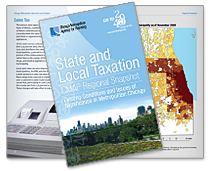 This report describes a range of key issues related to state and local tax policies across the Chicago metropolitan region, with an emphasis on the property tax, sales tax, income tax, and motor fuel tax. It also explains existing state and local revenue sharing arrangements and summarizes the available research on the relationship between taxation, business activity, and land use decisions. Today's metropolitan landscape is largely shaped by land use decisions made by local governments. In part, these decisions are motivated by local fiscal imperatives. As the regional agency responsible for producing a long range comprehensive plan, CMAP can play a valuable role by researching and analyzing ramifications of these local decisions as they play out across time and space.
This report describes a range of key issues related to state and local tax policies across the Chicago metropolitan region, with an emphasis on the property tax, sales tax, income tax, and motor fuel tax. It also explains existing state and local revenue sharing arrangements and summarizes the available research on the relationship between taxation, business activity, and land use decisions. Today's metropolitan landscape is largely shaped by land use decisions made by local governments. In part, these decisions are motivated by local fiscal imperatives. As the regional agency responsible for producing a long range comprehensive plan, CMAP can play a valuable role by researching and analyzing ramifications of these local decisions as they play out across time and space.
Available documents:
- State and Local Taxation Snapshot Report (16MB PDF)
- State and Local Taxation Snapshot Report (2 MB low res PDF)
Air Quality
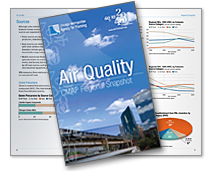 Poor air quality can impact our health, economy, and environment; regulations governing air quality play a role in where industries locate, how much energy is used, how we travel and how our transportation systems grow. It is an issue integrated into our daily life. This Regional Air Quality Snapshot describes current air quality conditions, sources, regulations, and efforts specific to northeastern Illinois. Our region is currently in nonattainment with federal standards, meaning it does not meet the requirements of the Clean Air Act and exceeds healthy air pollution levels. But the region's air quality has shown improvement, and there are numerous efforts in the region and the state to improve air quality. (Note that this snapshot does not directly address greenhouse gas emissions, including carbon dioxide; this important issue will be addressed in a separate report.)
Poor air quality can impact our health, economy, and environment; regulations governing air quality play a role in where industries locate, how much energy is used, how we travel and how our transportation systems grow. It is an issue integrated into our daily life. This Regional Air Quality Snapshot describes current air quality conditions, sources, regulations, and efforts specific to northeastern Illinois. Our region is currently in nonattainment with federal standards, meaning it does not meet the requirements of the Clean Air Act and exceeds healthy air pollution levels. But the region's air quality has shown improvement, and there are numerous efforts in the region and the state to improve air quality. (Note that this snapshot does not directly address greenhouse gas emissions, including carbon dioxide; this important issue will be addressed in a separate report.)
Available documents:
- Air Quality Snapshot Report (PDF)
- Air Quality Technical Report (782 KB PDF)
- Memo to Planning Coordinating Committee, January 2009 (PDF)
- Presentation to Transportation Committee, November 2008 (PDF)
- Memo to Environment Committee, September 2008 (PDF)
Jobs-Housing Balance
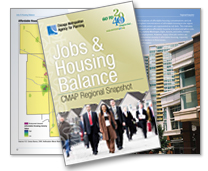 The purpose of the jobs-housing balance Regional Snapshot report is to explore the locations of affordable housing and jobs, determine the degree of mismatches between jobs and housing, and identify potential policies to address these mismatches.
The purpose of the jobs-housing balance Regional Snapshot report is to explore the locations of affordable housing and jobs, determine the degree of mismatches between jobs and housing, and identify potential policies to address these mismatches.
Available documents:
- Jobs-Housing Balance Snapshot Report (PDF)
- Jobs-Housing Balance Snapshot - DRAFT (2.45 MB PDF)
- Jobs-Housing Balance Technical Report (5.4 MB PDF)
- Scoping Presentation to Housing Committee (13 MB PPT)
For more information, contact Kendra Smith at 312-386-8774.
Industry Clusters
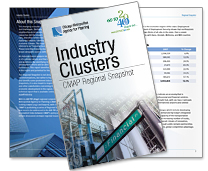 This Industry Clusters Regional Snapshot (7 MB PDF) provides an overview of the economy of northeastern Illinois and offers an analysis of industry clusters. Clusters are interdependent firms that are linked through the buyer-supplier relationship, share common resources and technologies, depend on similar labor pool and institutions, and rely on special infrastructure. By identifying industry clusters, business recruitment, attraction and development efforts will be able to focus on companies that complement existing businesses, enhance land-use decisions and make efficient use of the transportation network. This cluster report identifies several industry clusters that have a strong presence in the region, highlights emerging clusters that have potential for future growth, and introduces next steps for further development of a cluster based strategy for the region as part of the GO TO 2040 plan.
This Industry Clusters Regional Snapshot (7 MB PDF) provides an overview of the economy of northeastern Illinois and offers an analysis of industry clusters. Clusters are interdependent firms that are linked through the buyer-supplier relationship, share common resources and technologies, depend on similar labor pool and institutions, and rely on special infrastructure. By identifying industry clusters, business recruitment, attraction and development efforts will be able to focus on companies that complement existing businesses, enhance land-use decisions and make efficient use of the transportation network. This cluster report identifies several industry clusters that have a strong presence in the region, highlights emerging clusters that have potential for future growth, and introduces next steps for further development of a cluster based strategy for the region as part of the GO TO 2040 plan.
Available documents:
- Industry Clusters Technical Report- Final 6/24/09 (7 MB PDF)
- Industry Clusters Technical Report (low res)- Final 6/24/09 (1 MB PDF)
- Industry Clusters Technical Report- DRAFT (1.03 MB PDF)
- Memo to Planning Coordinating Committee, November 2008 (PDF)
For more information, contact Annie Byrne at (312) 386-8786.
Latinos in Our Region
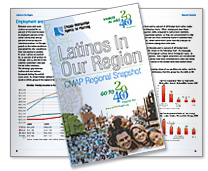 This Regional Snapshot (6 MB PDF) describes how Latino population growth could affect components of comprehensive planning, including employment, income, and education; land use, transportation, and housing; and quality of life issues such as health, recreation, and civic involvement. This snapshot also demonstrates that Latino population growth will affect the entire region, not just a few communities. Like previous immigrant groups, Latinos historically looked to the City of Chicago for homes, jobs, and a sense of community. This trend is changing, in that more Latinos now live in suburban areas than in Chicago. By strengthening and improving education, career opportunities, and communities for Latinos, the region as a whole can remain strong.See also the more-detailed technical document (PDF) that accompanies this report. Also available En Espanol (5MB PDF).
This Regional Snapshot (6 MB PDF) describes how Latino population growth could affect components of comprehensive planning, including employment, income, and education; land use, transportation, and housing; and quality of life issues such as health, recreation, and civic involvement. This snapshot also demonstrates that Latino population growth will affect the entire region, not just a few communities. Like previous immigrant groups, Latinos historically looked to the City of Chicago for homes, jobs, and a sense of community. This trend is changing, in that more Latinos now live in suburban areas than in Chicago. By strengthening and improving education, career opportunities, and communities for Latinos, the region as a whole can remain strong.See also the more-detailed technical document (PDF) that accompanies this report. Also available En Espanol (5MB PDF).
Available documents:
- Planning Impacts of Latino Population Growth snapshot- DRAFT (3.21 MB PDF)
- Planning Impacts of Latino Population Growth Technical Report- DRAFT 1 (610 KBPDF)
- Institute for Latino Studies Focus Group Summary (1 MB PDF)
- Population Projection Memo (337 KB PDF)
- Demographic Data – Latino Population Growth (270KB PDF)
- Socioeconomic Trends – Latino Population Growth (150KB PDF)
- Scoping Presentation to Human Services Committee (3 MB PPT)
The draft slideshowwas presented to the Human Services Committee on June 9th, 2008. For more information, contact Jon Hallas at 312-386-8764.
Infill and Redevelopment Regional Snapshot
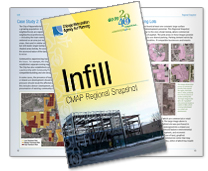 Published in March 2008, the Infill Snapshot (1.4 MBPDF) attempts to identify potential infill opportunities across the region. Three case studies illustrate the concept of infill and the unique challenges and opportunities that it may have indifferent communities.Urban infill development is a planning strategy that redirects growth from the urban and suburban fringes, or greenfields, into more dense urban cores to create compact, livable, and sustainable communities. This report identifies land suitable for infill development in Cook County, and estimates the potential for these sites to absorb future population growth. As more data becomes available, the research will be extended into the entire CMAP region. The report uses tax assessor data to locate vacant land and to calculate the Improvement-to-Land Value Ratio (I/L Ratio) to identify potentially under-utilized land. Special consideration is given to preserving existing farmland and open space, to increase habitat connectivity using Chicago Wilderness' Green Infrastructure Vision as a reference, and to assure that affordable housing is not counted as "under-utilized."
Published in March 2008, the Infill Snapshot (1.4 MBPDF) attempts to identify potential infill opportunities across the region. Three case studies illustrate the concept of infill and the unique challenges and opportunities that it may have indifferent communities.Urban infill development is a planning strategy that redirects growth from the urban and suburban fringes, or greenfields, into more dense urban cores to create compact, livable, and sustainable communities. This report identifies land suitable for infill development in Cook County, and estimates the potential for these sites to absorb future population growth. As more data becomes available, the research will be extended into the entire CMAP region. The report uses tax assessor data to locate vacant land and to calculate the Improvement-to-Land Value Ratio (I/L Ratio) to identify potentially under-utilized land. Special consideration is given to preserving existing farmland and open space, to increase habitat connectivity using Chicago Wilderness' Green Infrastructure Vision as a reference, and to assure that affordable housing is not counted as "under-utilized."
This general-interest publication is based on a more-technical report that was reviewed through CMAP's committee structure. That review process has included the followingtechnical documents.
Available documents:
- Technical Report (7 MB PDF)
- Memo to Planning Coordination Committee (PDF)
- Presentation of Initial Findings to Working Committees (1.44MBPDF)
For more information, contact Lindsay Bayley at 312-386-8826.
Sustainability Regional Snapshot
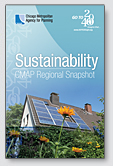 Published in December 2007, the Sustainability Snapshot (820KB PDF) is intended to define the concept of "sustainability" for use in developing the GO TO 2040 Plan, among other purposes. This snapshot proposes ways to measure sustainability by identifying potential indicators. It includes an analysis of the policy implications associated with addressing sustainability. This general-interest publication is based on a more-technical report that was reviewed through CMAP's committee structure. That review process has included the followingtechnical documents.
Published in December 2007, the Sustainability Snapshot (820KB PDF) is intended to define the concept of "sustainability" for use in developing the GO TO 2040 Plan, among other purposes. This snapshot proposes ways to measure sustainability by identifying potential indicators. It includes an analysis of the policy implications associated with addressing sustainability. This general-interest publication is based on a more-technical report that was reviewed through CMAP's committee structure. That review process has included the followingtechnical documents.
Available documents:
- Technical Report (712KB PDF)
- Presentation to CMAP Board on Sustainability Policy Issues (1MB PPT)
- Memo to CMAP Board on Sustainability Policy Issues (220KB PDF)
- Presentation to Working Committees on Draft Technical Report (2 MB PPT)
- Presentation of Initial Findings to Working Committees (1 MBPDF)
For more information about the sustainability snapshot, contact Jesse Elam at 312-386-8688.
Original Regional Snapshot
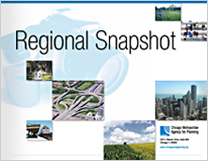 The first Regional Snapshot (9 MB PDF), published in February2007, was a general overview of the primary issues that CMAP began to address in the agency's first year of existence. It includes data about population, natural resources, transportation, the economy, and housing. Click here for details about the methodology and data sources behind that original snapshot.
The first Regional Snapshot (9 MB PDF), published in February2007, was a general overview of the primary issues that CMAP began to address in the agency's first year of existence. It includes data about population, natural resources, transportation, the economy, and housing. Click here for details about the methodology and data sources behind that original snapshot.
Aug 9, 2013
CMAP Regional Snapshot Series
As part of its GO TO 2040 comprehensive planning process, CMAP has instituted a series of Regional Snapshot reports. These studies are meant to depict where the region stands in measurable terms, regarding fundamental issues that will shape our communities in years to come. Numerous partners across the region have done much good work to quantify the status and needs of metropolitan Chicago; CMAP's role is to coordinate and enhance activities across those areas while promoting regional priorities. The Regional Snapshot seriesis not intended as an all-encompassing overview of northeastern Illinois. Each report is instead a short encapsulation of selected trends and data points that shed light on issues that have been identified as priorities in the region.
State and Local Taxation
 This report describes a range of key issues related to state and local tax policies across the Chicago metropolitan region, with an emphasis on the property tax, sales tax, income tax, and motor fuel tax. It also explains existing state and local revenue sharing arrangements and summarizes the available research on the relationship between taxation, business activity, and land use decisions. Today's metropolitan landscape is largely shaped by land use decisions made by local governments. In part, these decisions are motivated by local fiscal imperatives. As the regional agency responsible for producing a long range comprehensive plan, CMAP can play a valuable role by researching and analyzing ramifications of these local decisions as they play out across time and space.
This report describes a range of key issues related to state and local tax policies across the Chicago metropolitan region, with an emphasis on the property tax, sales tax, income tax, and motor fuel tax. It also explains existing state and local revenue sharing arrangements and summarizes the available research on the relationship between taxation, business activity, and land use decisions. Today's metropolitan landscape is largely shaped by land use decisions made by local governments. In part, these decisions are motivated by local fiscal imperatives. As the regional agency responsible for producing a long range comprehensive plan, CMAP can play a valuable role by researching and analyzing ramifications of these local decisions as they play out across time and space.
Available documents:
- State and Local Taxation Snapshot Report (16MB PDF)
- State and Local Taxation Snapshot Report (2 MB low res PDF)
Air Quality
 Poor air quality can impact our health, economy, and environment; regulations governing air quality play a role in where industries locate, how much energy is used, how we travel and how our transportation systems grow. It is an issue integrated into our daily life. This Regional Air Quality Snapshot describes current air quality conditions, sources, regulations, and efforts specific to northeastern Illinois. Our region is currently in nonattainment with federal standards, meaning it does not meet the requirements of the Clean Air Act and exceeds healthy air pollution levels. But the region's air quality has shown improvement, and there are numerous efforts in the region and the state to improve air quality. (Note that this snapshot does not directly address greenhouse gas emissions, including carbon dioxide; this important issue will be addressed in a separate report.)
Poor air quality can impact our health, economy, and environment; regulations governing air quality play a role in where industries locate, how much energy is used, how we travel and how our transportation systems grow. It is an issue integrated into our daily life. This Regional Air Quality Snapshot describes current air quality conditions, sources, regulations, and efforts specific to northeastern Illinois. Our region is currently in nonattainment with federal standards, meaning it does not meet the requirements of the Clean Air Act and exceeds healthy air pollution levels. But the region's air quality has shown improvement, and there are numerous efforts in the region and the state to improve air quality. (Note that this snapshot does not directly address greenhouse gas emissions, including carbon dioxide; this important issue will be addressed in a separate report.)
Available documents:
- Air Quality Snapshot Report (PDF)
- Air Quality Technical Report (782 KB PDF)
- Memo to Planning Coordinating Committee, January 2009 (PDF)
- Presentation to Transportation Committee, November 2008 (PDF)
- Memo to Environment Committee, September 2008 (PDF)
Jobs-Housing Balance
 The purpose of the jobs-housing balance Regional Snapshot report is to explore the locations of affordable housing and jobs, determine the degree of mismatches between jobs and housing, and identify potential policies to address these mismatches.
The purpose of the jobs-housing balance Regional Snapshot report is to explore the locations of affordable housing and jobs, determine the degree of mismatches between jobs and housing, and identify potential policies to address these mismatches.
Available documents:
- Jobs-Housing Balance Snapshot Report (PDF)
- Jobs-Housing Balance Snapshot - DRAFT (2.45 MB PDF)
- Jobs-Housing Balance Technical Report (5.4 MB PDF)
- Scoping Presentation to Housing Committee (13 MB PPT)
For more information, contact Kendra Smith at 312-386-8774.
Industry Clusters
 This Industry Clusters Regional Snapshot (7 MB PDF) provides an overview of the economy of northeastern Illinois and offers an analysis of industry clusters. Clusters are interdependent firms that are linked through the buyer-supplier relationship, share common resources and technologies, depend on similar labor pool and institutions, and rely on special infrastructure. By identifying industry clusters, business recruitment, attraction and development efforts will be able to focus on companies that complement existing businesses, enhance land-use decisions and make efficient use of the transportation network. This cluster report identifies several industry clusters that have a strong presence in the region, highlights emerging clusters that have potential for future growth, and introduces next steps for further development of a cluster based strategy for the region as part of the GO TO 2040 plan.
This Industry Clusters Regional Snapshot (7 MB PDF) provides an overview of the economy of northeastern Illinois and offers an analysis of industry clusters. Clusters are interdependent firms that are linked through the buyer-supplier relationship, share common resources and technologies, depend on similar labor pool and institutions, and rely on special infrastructure. By identifying industry clusters, business recruitment, attraction and development efforts will be able to focus on companies that complement existing businesses, enhance land-use decisions and make efficient use of the transportation network. This cluster report identifies several industry clusters that have a strong presence in the region, highlights emerging clusters that have potential for future growth, and introduces next steps for further development of a cluster based strategy for the region as part of the GO TO 2040 plan.
Available documents:
- Industry Clusters Technical Report- Final 6/24/09 (7 MB PDF)
- Industry Clusters Technical Report (low res)- Final 6/24/09 (1 MB PDF)
- Industry Clusters Technical Report- DRAFT (1.03 MB PDF)
- Memo to Planning Coordinating Committee, November 2008 (PDF)
For more information, contact Annie Byrne at (312) 386-8786.
Latinos in Our Region
 This Regional Snapshot (6 MB PDF) describes how Latino population growth could affect components of comprehensive planning, including employment, income, and education; land use, transportation, and housing; and quality of life issues such as health, recreation, and civic involvement. This snapshot also demonstrates that Latino population growth will affect the entire region, not just a few communities. Like previous immigrant groups, Latinos historically looked to the City of Chicago for homes, jobs, and a sense of community. This trend is changing, in that more Latinos now live in suburban areas than in Chicago. By strengthening and improving education, career opportunities, and communities for Latinos, the region as a whole can remain strong.See also the more-detailed technical document (PDF) that accompanies this report. Also available En Espanol (5MB PDF).
This Regional Snapshot (6 MB PDF) describes how Latino population growth could affect components of comprehensive planning, including employment, income, and education; land use, transportation, and housing; and quality of life issues such as health, recreation, and civic involvement. This snapshot also demonstrates that Latino population growth will affect the entire region, not just a few communities. Like previous immigrant groups, Latinos historically looked to the City of Chicago for homes, jobs, and a sense of community. This trend is changing, in that more Latinos now live in suburban areas than in Chicago. By strengthening and improving education, career opportunities, and communities for Latinos, the region as a whole can remain strong.See also the more-detailed technical document (PDF) that accompanies this report. Also available En Espanol (5MB PDF).
Available documents:
- Planning Impacts of Latino Population Growth snapshot- DRAFT (3.21 MB PDF)
- Planning Impacts of Latino Population Growth Technical Report- DRAFT 1 (610 KBPDF)
- Institute for Latino Studies Focus Group Summary (1 MB PDF)
- Population Projection Memo (337 KB PDF)
- Demographic Data – Latino Population Growth (270KB PDF)
- Socioeconomic Trends – Latino Population Growth (150KB PDF)
- Scoping Presentation to Human Services Committee (3 MB PPT)
The draft slideshowwas presented to the Human Services Committee on June 9th, 2008. For more information, contact Jon Hallas at 312-386-8764.
Infill and Redevelopment Regional Snapshot
 Published in March 2008, the Infill Snapshot (1.4 MBPDF) attempts to identify potential infill opportunities across the region. Three case studies illustrate the concept of infill and the unique challenges and opportunities that it may have indifferent communities.Urban infill development is a planning strategy that redirects growth from the urban and suburban fringes, or greenfields, into more dense urban cores to create compact, livable, and sustainable communities. This report identifies land suitable for infill development in Cook County, and estimates the potential for these sites to absorb future population growth. As more data becomes available, the research will be extended into the entire CMAP region. The report uses tax assessor data to locate vacant land and to calculate the Improvement-to-Land Value Ratio (I/L Ratio) to identify potentially under-utilized land. Special consideration is given to preserving existing farmland and open space, to increase habitat connectivity using Chicago Wilderness' Green Infrastructure Vision as a reference, and to assure that affordable housing is not counted as "under-utilized."
Published in March 2008, the Infill Snapshot (1.4 MBPDF) attempts to identify potential infill opportunities across the region. Three case studies illustrate the concept of infill and the unique challenges and opportunities that it may have indifferent communities.Urban infill development is a planning strategy that redirects growth from the urban and suburban fringes, or greenfields, into more dense urban cores to create compact, livable, and sustainable communities. This report identifies land suitable for infill development in Cook County, and estimates the potential for these sites to absorb future population growth. As more data becomes available, the research will be extended into the entire CMAP region. The report uses tax assessor data to locate vacant land and to calculate the Improvement-to-Land Value Ratio (I/L Ratio) to identify potentially under-utilized land. Special consideration is given to preserving existing farmland and open space, to increase habitat connectivity using Chicago Wilderness' Green Infrastructure Vision as a reference, and to assure that affordable housing is not counted as "under-utilized."
This general-interest publication is based on a more-technical report that was reviewed through CMAP's committee structure. That review process has included the followingtechnical documents.
Available documents:
- Technical Report (7 MB PDF)
- Memo to Planning Coordination Committee (PDF)
- Presentation of Initial Findings to Working Committees (1.44MBPDF)
For more information, contact Lindsay Bayley at 312-386-8826.
Sustainability Regional Snapshot
 Published in December 2007, the Sustainability Snapshot (820KB PDF) is intended to define the concept of "sustainability" for use in developing the GO TO 2040 Plan, among other purposes. This snapshot proposes ways to measure sustainability by identifying potential indicators. It includes an analysis of the policy implications associated with addressing sustainability. This general-interest publication is based on a more-technical report that was reviewed through CMAP's committee structure. That review process has included the followingtechnical documents.
Published in December 2007, the Sustainability Snapshot (820KB PDF) is intended to define the concept of "sustainability" for use in developing the GO TO 2040 Plan, among other purposes. This snapshot proposes ways to measure sustainability by identifying potential indicators. It includes an analysis of the policy implications associated with addressing sustainability. This general-interest publication is based on a more-technical report that was reviewed through CMAP's committee structure. That review process has included the followingtechnical documents.
Available documents:
- Technical Report (712KB PDF)
- Presentation to CMAP Board on Sustainability Policy Issues (1MB PPT)
- Memo to CMAP Board on Sustainability Policy Issues (220KB PDF)
- Presentation to Working Committees on Draft Technical Report (2 MB PPT)
- Presentation of Initial Findings to Working Committees (1 MBPDF)
For more information about the sustainability snapshot, contact Jesse Elam at 312-386-8688.
Original Regional Snapshot
 The first Regional Snapshot (9 MB PDF), published in February2007, was a general overview of the primary issues that CMAP began to address in the agency's first year of existence. It includes data about population, natural resources, transportation, the economy, and housing. Click here for details about the methodology and data sources behind that original snapshot.
The first Regional Snapshot (9 MB PDF), published in February2007, was a general overview of the primary issues that CMAP began to address in the agency's first year of existence. It includes data about population, natural resources, transportation, the economy, and housing. Click here for details about the methodology and data sources behind that original snapshot.